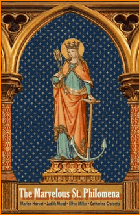Manners, Customs, Clothing
 |
 |
 |
 |
 |
 |
 |
What about Krampus Night?
A TIA reader’s request to know more about the Krampus Night found its way to my desk, and I was pleased to do some research on the topic. Let me address it first with a bit of history on that traditional Alpine custom and then look at how it has resurged with more a sinister tone.
Krampus Night: A lesson about good & evil
In many countries of Europe, December 5, the eve of the Feast of St. Nicholas, was celebrated as the first of the festivities of the Christmas Season. As early as the 1700s in the villages of Austria, Southern Germany, the Tyrol regions of Switzerland and Italy and other Eastern European countries, on the evening of December 5, the good Bishop St. Nicholas himself would knock on the doors of the mountain huts to reward the good children with a blessing and a simple gift, usually candy or fruit.
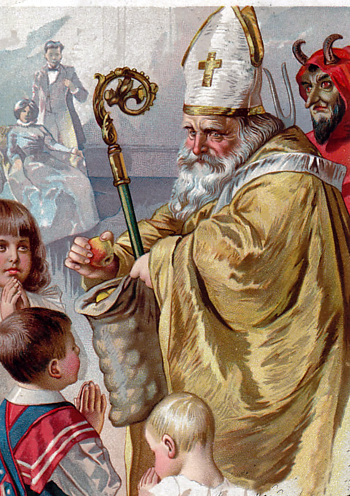 St. Nicholas was accompanied, however, by another more fearsome personage, Krampus, a word that comes from the German krampen, which translates as claw. This horned figure from Hell with clawed feet and a red tongue punished the naughty children and threatened to take them to his fiery abode if they did not mend their bad ways.
St. Nicholas was accompanied, however, by another more fearsome personage, Krampus, a word that comes from the German krampen, which translates as claw. This horned figure from Hell with clawed feet and a red tongue punished the naughty children and threatened to take them to his fiery abode if they did not mend their bad ways.
This custom was of healthy Catholic inspiration: Krampus Night, as it came to be called in many regions, was a lesson to remind children that there are, indeed, terrible consequences to bad behavior, an arresting sign that the wide and easy path of vice leads to Hell.
The chains Krampus carried and thrashed for effect symbolize the binding of the Devil by the Catholic Church. The cowbells he used to wear or carry reminded the children that this Krampus Devil they saw was bound by the Church, who has power over the Devil and protects the children with her blessing. But, they should be aware that if they did not behave well they would go to Hell, where the Devil inflicts every kind of suffering on his victims.
Krampus also carried birch branches and occasionally swatted misbehaved boys with them, another palpable reminder that evil deeds will be punished. Sometimes Krampus appeared with a sack or washtub strapped to his back to cart off the particularly bad children to drown with him back to Hell. So goes the warnings of parents to their children: “You should better behave. St. Nicholas and Krampus are coming!”
The good angel at the side of St. Nicholas, however, often would intercede for the miscreant and the furious Krampus was forced to leave, rattling his chains and grumbling over his empty bag.
The Krampus costumes were homemade with as many varieties as there are regions. In the Tyrol, for example, there was a breed of Krampus that would appear in a voluminous straw suit. In other places the Krampus costume was fashioned from the horns and pelts of mountain goats or sheep.
 These characters who accompanied St. Nicholas were always fearsome, but their ugliness never transgressed the bounds of good sense. Krampus was intended to frighten, but not to terrify. The sturdy boys and girls of the Alps did not develop complexes or have nightmares because of Krampus. On the contrary, they looked forward to the visit of St. Nicholas and the threatening Krampus.
These characters who accompanied St. Nicholas were always fearsome, but their ugliness never transgressed the bounds of good sense. Krampus was intended to frighten, but not to terrify. The sturdy boys and girls of the Alps did not develop complexes or have nightmares because of Krampus. On the contrary, they looked forward to the visit of St. Nicholas and the threatening Krampus.
Of course, the central figure of the festivity was St. Nicholas accompanied by several good angels who carried the treats. Krampus, albeit colorful and popular, was the secondary figure, representing the Devil conquered by the Saint and the Holy Church, a reminder to young and old that we must also conquer the Devil and vice to merit our place in Heaven.
To have an idea of how St. Nicholas Day was celebrated in Austria in early 20th century, I suggest you watch this charming video made in 1934. In it you will see St. Nicholas emerge from Church with an angel and followed by Krampus devils with homemade masks, hairy suits, chains and red ribbons symbolizing the whips used to chastise bad children.
The group makes its way to an Alpine cottage, where a whole family is waiting to greet the Saint. The mother gives the names of the good children and each receives a gift. Afterward, one naughty boy in this obviously staged event sticks out his tongue, and he is carried away by a Krampus in the bag on his back.
The small drama is charming, innocent and a marvelous pedagogic tool to form youth: Good is rewarded; bad is punished.
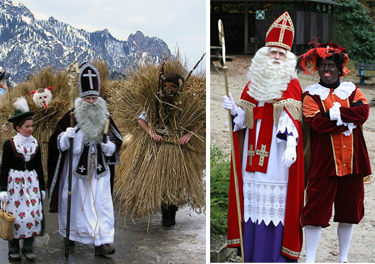 Throughout Eastern and Western Europe, the kindly St. Nicholas was linked with a bad counterpart who punishes. In Northern Germany, he is known as Knecht Ruprecht, a sooty companion in black rags who goes down chimneys and leaves twigs or rods for bad children. In the Czech Republic, he is called Čert, literally a Devil who looks like an goat with a foot-long scarlet tongue and the face and hands of man. In parts of Bavaria, Krampus appears in a voluminous straw suit and is called the Buttmandl.
Throughout Eastern and Western Europe, the kindly St. Nicholas was linked with a bad counterpart who punishes. In Northern Germany, he is known as Knecht Ruprecht, a sooty companion in black rags who goes down chimneys and leaves twigs or rods for bad children. In the Czech Republic, he is called Čert, literally a Devil who looks like an goat with a foot-long scarlet tongue and the face and hands of man. In parts of Bavaria, Krampus appears in a voluminous straw suit and is called the Buttmandl.
In Luxemburg he is Houseker and other parts of the Low Countries we find Swarte Piet (Black Peter). Rubbels is his name in German-speaking Lorraine, Hans Trapp in Alsace and Le Père Fouettard in Northern and Eastern France.
The names and costumes abound, but the role is always the same. Krampus and these other companions of St. Nicholas are there to warn bad children to mend their ways so that they do not end up in an eternity of Hell.
By the 20th century the Krampusnaucht (Krampus Night) had become a city or town festival celebrated in its town square. Families gathered to greet St. Nicholas, who was followed by a group of Krampuses who threatened naughty children with their whips in their devilish dress.
By the 1940s the Austrian government came to take a dim few of this festivity, which often became rowdy when the Krampuses imbibed too many spirits. The Krampus tradition was prohibited by the Dollfuss regime under the Nazis, and, in the 1950s, the government distributed pamphlets titled "Krampus is an Evil Man." The Krampusnacht parade fell into disuse.
Notwithstanding, the familiar companion did not die in the homes and countryside, and Krampus continued to appear at the side of St. Nicholas as a warning for naughty children to behave.
A new twist on Krampusnaucht
Toward the end of the century, a popular resurgence of Krampus celebrations occurred in Europe and continues today, even making their way into the United States.
The modern Krampusnacht, however, has taken a new turn. First, the Krampus societies that have cropped up across Europe and in the U.S. emphasize the festival as a pagan pre-Catholic tradition. The aim is not to highlight St. Nicholas, but to emphasize the monster creatures.
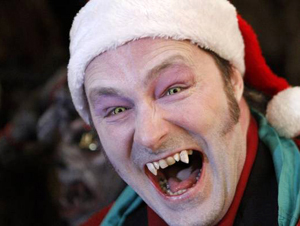 Especially in the American parades St. Nicholas has virtually disappeared. Instead, we find a few Santa Clauses, like the vampire Santa at right who paraded in the 2014
Dallas-Fort Worth event, along with a legion of Krampuses and their devilish props: flaming carts carrying children off to Hell, hellish tools of torment, etc.
Especially in the American parades St. Nicholas has virtually disappeared. Instead, we find a few Santa Clauses, like the vampire Santa at right who paraded in the 2014
Dallas-Fort Worth event, along with a legion of Krampuses and their devilish props: flaming carts carrying children off to Hell, hellish tools of torment, etc.
Krampus Night has become part of a growing movement of “anti-Christmas” celebrations, backed by pagan and Wicca groups, especially in North America. You can find books about ‘the dark side’ of Christmas written by witches and warlocks that trumpet Krampus as the “Devil of Christmas” to replace St. Nicholas and Santa.
The extravagant horrendous costumes and opportunity to parade in the streets also makes the Krampus Parade popular with the homosexual communities in large urban centers like Los Angeles, New York and Dallas.
In Europe as well, the Krampus parades have come to be dominated by the Devils. St. Nicholas makes a brief appearance, but, as you can see in recent German and Austrian YouTube videos - here and here, for example – hordes of horrendous Devils in elaborate costumes - whose average cost is $1,000 - make the traditional Krampus in his homemade gear appear almost gentle by comparison.
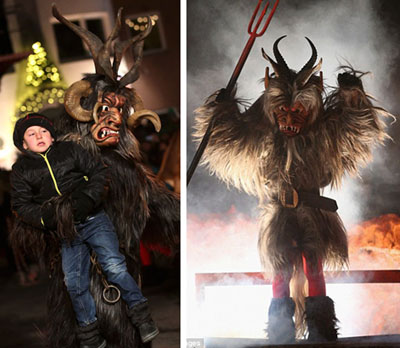 The music also has changed accordingly: Christmas carols are replaced by a gyrating hard rock – the music of Hell – drives the parades.
The music also has changed accordingly: Christmas carols are replaced by a gyrating hard rock – the music of Hell – drives the parades.
This is not a parade of St. Nicholas, as originally intended, to show the triumph of good over evil. Rather, it is a parade of Krampus demons, demonstrating the modern day fascination with the demonic and horrendous.
Some children who are carted away by the Krampuses will later re-emerge, triumphantly dressed as a creature of Hell. Such children, immunized against demons and monsters by constant contact with them on video games and television, no longer fear the Devil but have become co-natural with them.
The good Catholic custom is being transformed into a pagan celebration of the Devil. These new Krampus Night parades do not offer good lessons or provide a wholesome environment for either children or adults. Quite the opposite…
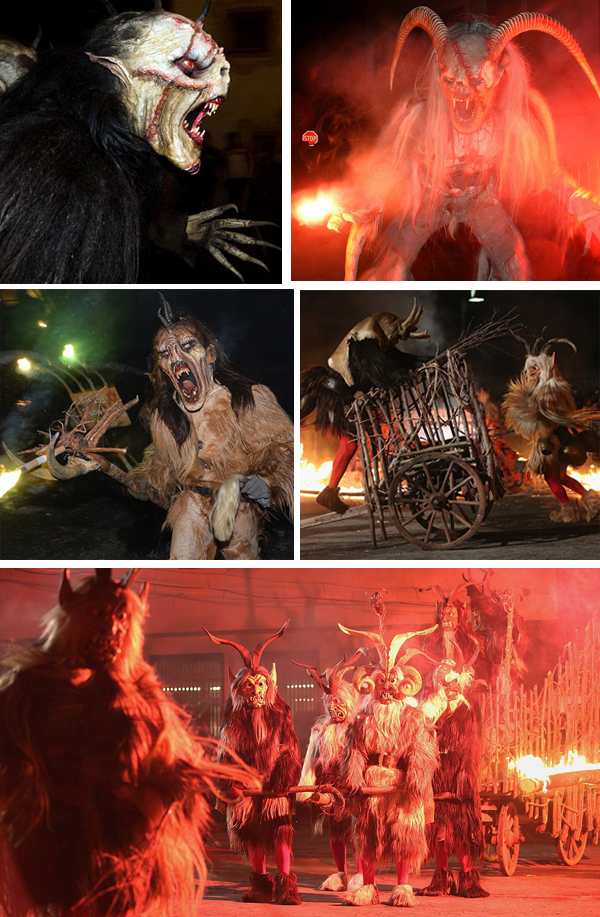

Krampus Night: A lesson about good & evil
In many countries of Europe, December 5, the eve of the Feast of St. Nicholas, was celebrated as the first of the festivities of the Christmas Season. As early as the 1700s in the villages of Austria, Southern Germany, the Tyrol regions of Switzerland and Italy and other Eastern European countries, on the evening of December 5, the good Bishop St. Nicholas himself would knock on the doors of the mountain huts to reward the good children with a blessing and a simple gift, usually candy or fruit.

An old Austria postcard depicting St. Nicholas and Krampus
This custom was of healthy Catholic inspiration: Krampus Night, as it came to be called in many regions, was a lesson to remind children that there are, indeed, terrible consequences to bad behavior, an arresting sign that the wide and easy path of vice leads to Hell.
The chains Krampus carried and thrashed for effect symbolize the binding of the Devil by the Catholic Church. The cowbells he used to wear or carry reminded the children that this Krampus Devil they saw was bound by the Church, who has power over the Devil and protects the children with her blessing. But, they should be aware that if they did not behave well they would go to Hell, where the Devil inflicts every kind of suffering on his victims.
Krampus also carried birch branches and occasionally swatted misbehaved boys with them, another palpable reminder that evil deeds will be punished. Sometimes Krampus appeared with a sack or washtub strapped to his back to cart off the particularly bad children to drown with him back to Hell. So goes the warnings of parents to their children: “You should better behave. St. Nicholas and Krampus are coming!”
The good angel at the side of St. Nicholas, however, often would intercede for the miscreant and the furious Krampus was forced to leave, rattling his chains and grumbling over his empty bag.
The Krampus costumes were homemade with as many varieties as there are regions. In the Tyrol, for example, there was a breed of Krampus that would appear in a voluminous straw suit. In other places the Krampus costume was fashioned from the horns and pelts of mountain goats or sheep.

St. Nicholas and severall Krampuses
head out to visit the Alpine homes
Of course, the central figure of the festivity was St. Nicholas accompanied by several good angels who carried the treats. Krampus, albeit colorful and popular, was the secondary figure, representing the Devil conquered by the Saint and the Holy Church, a reminder to young and old that we must also conquer the Devil and vice to merit our place in Heaven.
To have an idea of how St. Nicholas Day was celebrated in Austria in early 20th century, I suggest you watch this charming video made in 1934. In it you will see St. Nicholas emerge from Church with an angel and followed by Krampus devils with homemade masks, hairy suits, chains and red ribbons symbolizing the whips used to chastise bad children.
The group makes its way to an Alpine cottage, where a whole family is waiting to greet the Saint. The mother gives the names of the good children and each receives a gift. Afterward, one naughty boy in this obviously staged event sticks out his tongue, and he is carried away by a Krampus in the bag on his back.
The small drama is charming, innocent and a marvelous pedagogic tool to form youth: Good is rewarded; bad is punished.

Other companions of St. Nicholas,
Buttmandl and Black Peter (Swarte Piet)
In Luxemburg he is Houseker and other parts of the Low Countries we find Swarte Piet (Black Peter). Rubbels is his name in German-speaking Lorraine, Hans Trapp in Alsace and Le Père Fouettard in Northern and Eastern France.
The names and costumes abound, but the role is always the same. Krampus and these other companions of St. Nicholas are there to warn bad children to mend their ways so that they do not end up in an eternity of Hell.
By the 20th century the Krampusnaucht (Krampus Night) had become a city or town festival celebrated in its town square. Families gathered to greet St. Nicholas, who was followed by a group of Krampuses who threatened naughty children with their whips in their devilish dress.
By the 1940s the Austrian government came to take a dim few of this festivity, which often became rowdy when the Krampuses imbibed too many spirits. The Krampus tradition was prohibited by the Dollfuss regime under the Nazis, and, in the 1950s, the government distributed pamphlets titled "Krampus is an Evil Man." The Krampusnacht parade fell into disuse.
Notwithstanding, the familiar companion did not die in the homes and countryside, and Krampus continued to appear at the side of St. Nicholas as a warning for naughty children to behave.
A new twist on Krampusnaucht
Toward the end of the century, a popular resurgence of Krampus celebrations occurred in Europe and continues today, even making their way into the United States.
The modern Krampusnacht, however, has taken a new turn. First, the Krampus societies that have cropped up across Europe and in the U.S. emphasize the festival as a pagan pre-Catholic tradition. The aim is not to highlight St. Nicholas, but to emphasize the monster creatures.

Santa Claus himself appears with Dracula features
Krampus Night has become part of a growing movement of “anti-Christmas” celebrations, backed by pagan and Wicca groups, especially in North America. You can find books about ‘the dark side’ of Christmas written by witches and warlocks that trumpet Krampus as the “Devil of Christmas” to replace St. Nicholas and Santa.
The extravagant horrendous costumes and opportunity to parade in the streets also makes the Krampus Parade popular with the homosexual communities in large urban centers like Los Angeles, New York and Dallas.
In Europe as well, the Krampus parades have come to be dominated by the Devils. St. Nicholas makes a brief appearance, but, as you can see in recent German and Austrian YouTube videos - here and here, for example – hordes of horrendous Devils in elaborate costumes - whose average cost is $1,000 - make the traditional Krampus in his homemade gear appear almost gentle by comparison.

A boy in Haiming, Austria, is taken away by Krampus and reappears as a devil
This is not a parade of St. Nicholas, as originally intended, to show the triumph of good over evil. Rather, it is a parade of Krampus demons, demonstrating the modern day fascination with the demonic and horrendous.
Some children who are carted away by the Krampuses will later re-emerge, triumphantly dressed as a creature of Hell. Such children, immunized against demons and monsters by constant contact with them on video games and television, no longer fear the Devil but have become co-natural with them.
The good Catholic custom is being transformed into a pagan celebration of the Devil. These new Krampus Night parades do not offer good lessons or provide a wholesome environment for either children or adults. Quite the opposite…

What was conceived to be an innocent performance to form children, became an exaltation of devilish horror. Above, scenes from recent Krampus parades in Salzburg

Posted January 7, 2015
______________________
______________________





